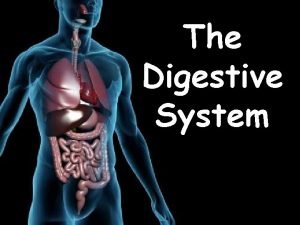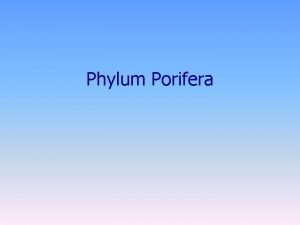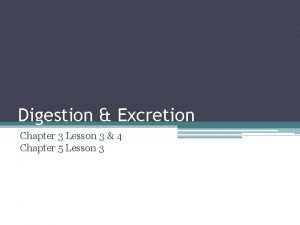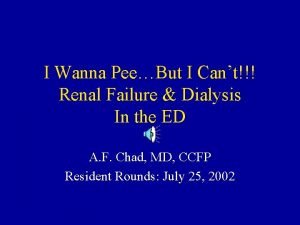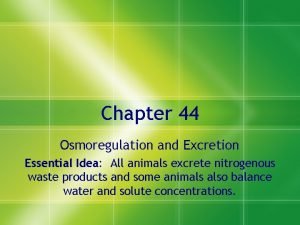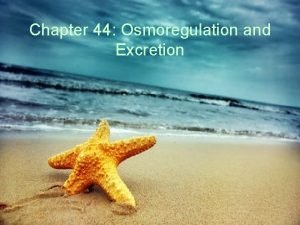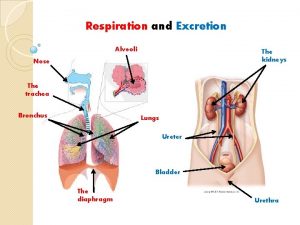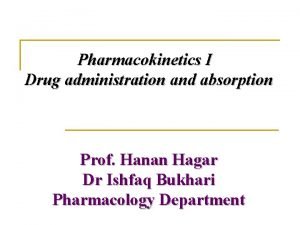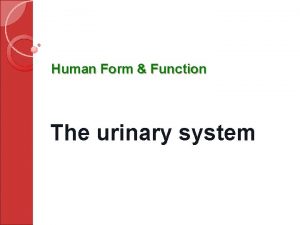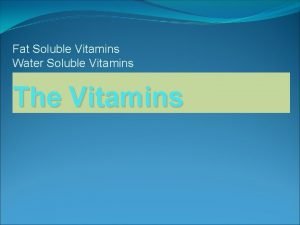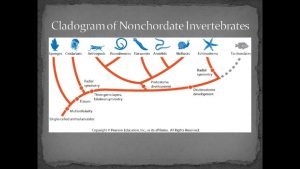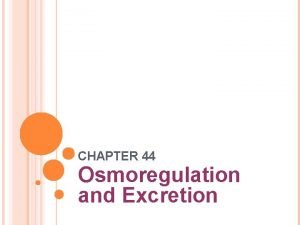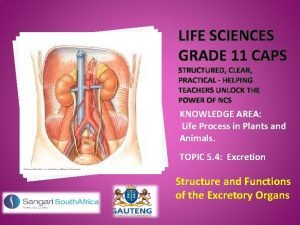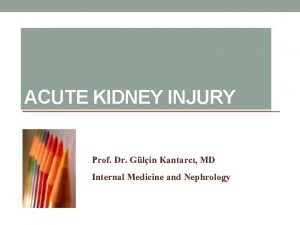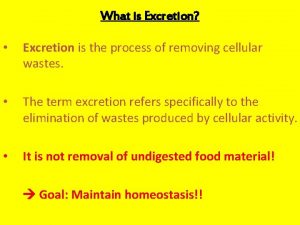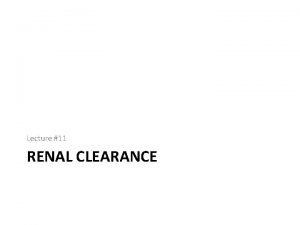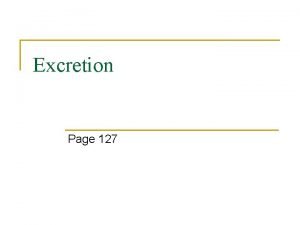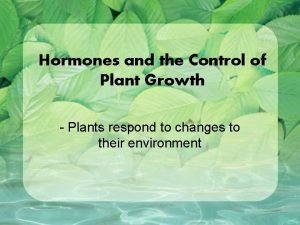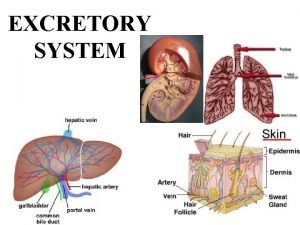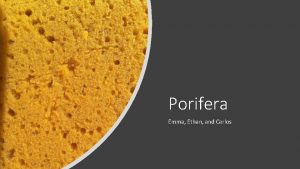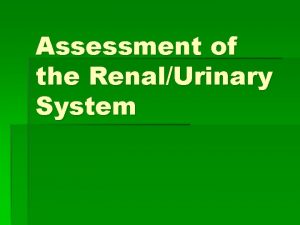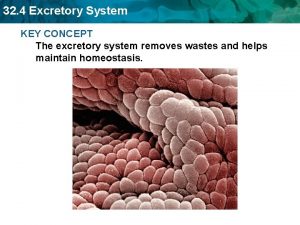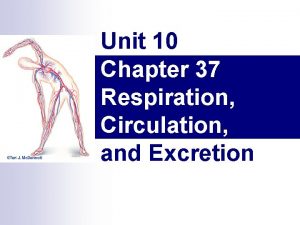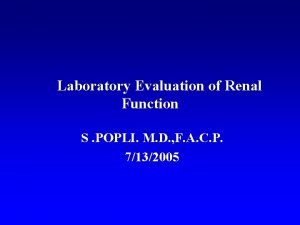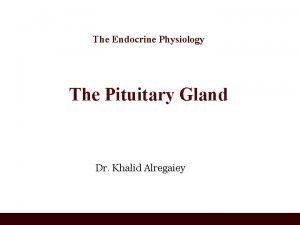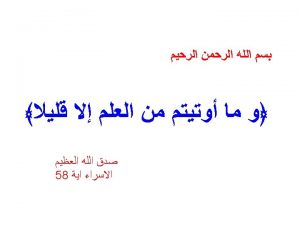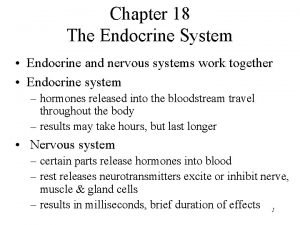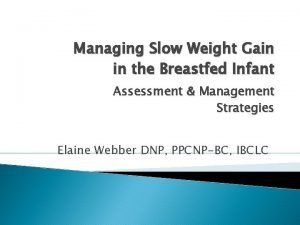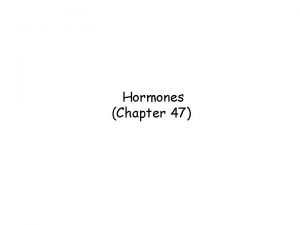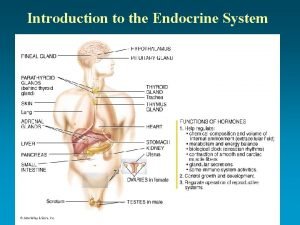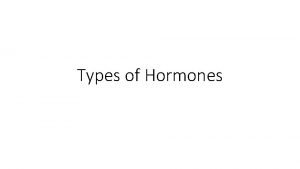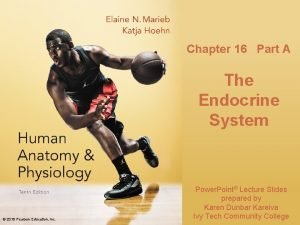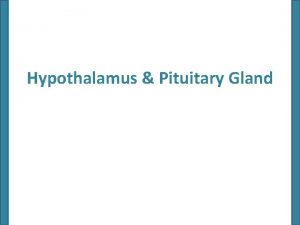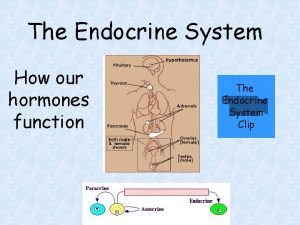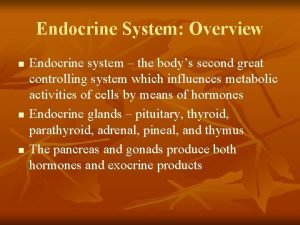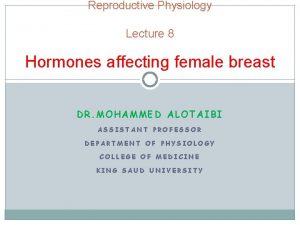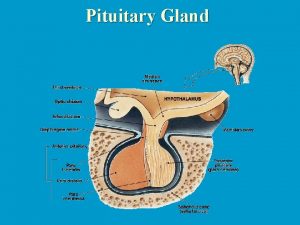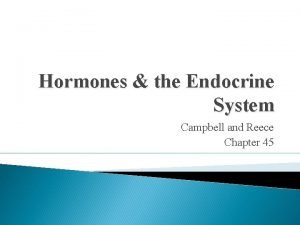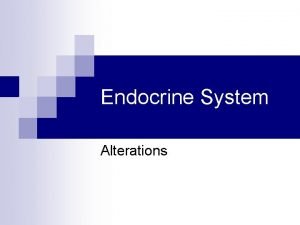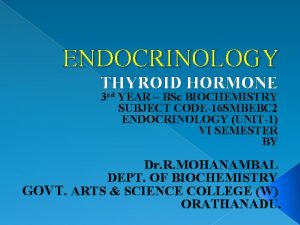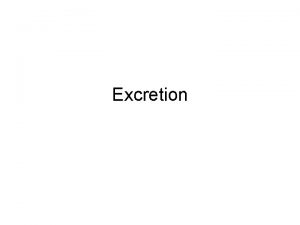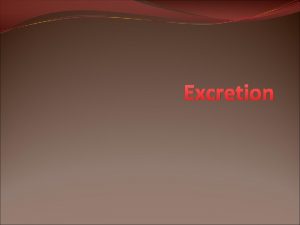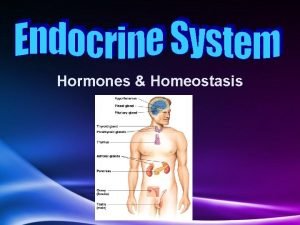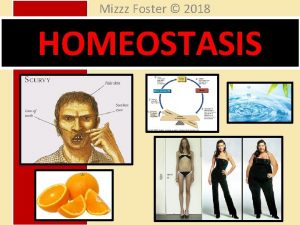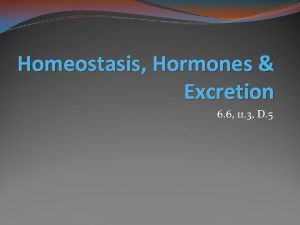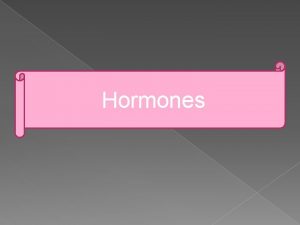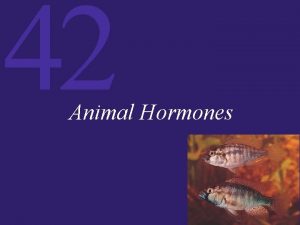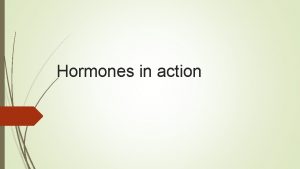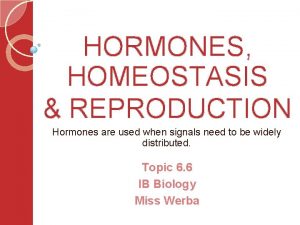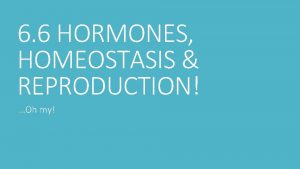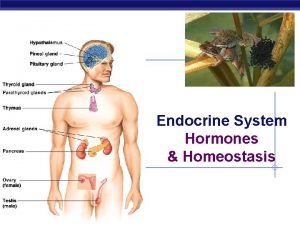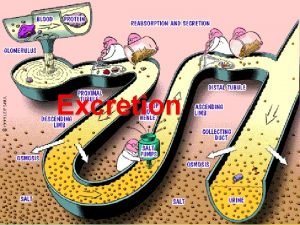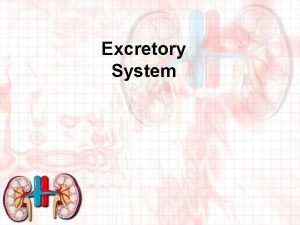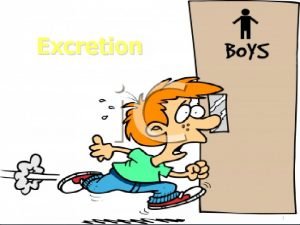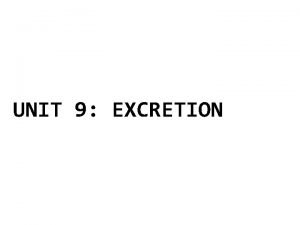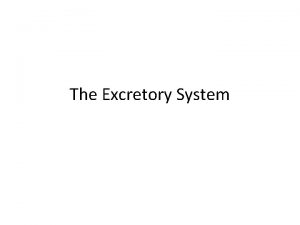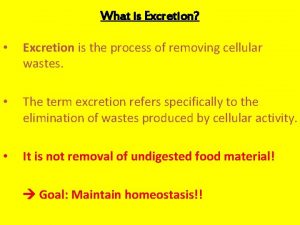Homeostasis Hormones Excretion 6 6 D 5 Homeostasis























































- Slides: 55

Homeostasis, Hormones & Excretion 6. 6, D. 5

Homeostasis The human body works best under the following conditions: Body temperature of 37°C 0. 1 % blood sugar level Blood p. H level of ~7. 4 The external environment can alter these levels Ex: Outside temperature, physical activity, meals…

HOMEOSTASIS is the maintenance of the internal environment within an acceptable range, despite fluctuations in the external environment. It creates a dynamic equilibrium: a stable condition with fluctuating limits

Homeostasis Requires constant monitoring and feedback about body conditions. Homeostasis requires the interaction of several regulatory systems I. e. : Nervous system, respiratory system, endocrine system, the excretory system, the circulatory system….

Ex of Biological Homeostasis: Blood p. H Carbon dioxide concentration Blood glucose concentration Body temperature Water balance Blood pressure

What’s wrong with this graph?

Blood p. H Homeostatic level is p. H 7. 4 Narrow acceptable range: 7. 35 -7. 45 < 7. 35 = acidosis >7. 45 = alkalosis Non-homeostatic levels can cause blood proteins and enzymes to ionize and change shape and function.

Blood p. H is maintained by the carbonic acidbicarbonate buffer system BUFFER: substance that maintains p. H H 2 O + CO 2 water carbon dioxide H 2 CO 3 carbonic acid HCO 3 - + H+ bicarbonate hydrogen ion

Low p. H Ex: after eating a vinaigrette salad, H+ ions will enter the bloodstream, and the blood will become too acidic (p. H to low!) The increase in H+ means that there is a greater chance of HCO 3 - ions finding a H+ and forming H 2 CO 3, thus increasing the p. H

High p. H When a base enters the blood stream, the p. H will rise making it more basic because the base will bond with H+ and remove them from the blood. To compensate, H 2 CO 3 ionizes to replace the missing H+ and lower the p. H back to acceptable ranges

Carbon Dioxide Concentration Oxygen and Carbon Dioxide concentration are maintained with the aide of chemoreceptors in the walls of certain blood vessels that can cause an increase or decrease in breathing rate.

Negative Feedback Systems Mechanisms that make adjustments to bring the body back within an acceptable range (like a thermostat) With negative feedback, the result of a process causes a reversal of the result. Homeostasis relies on negative feedback systems to maintain homeostatic levels

Negative Feedback A thermostat is an example of negative feedback. Temperature Rises Temp Decreases Temp change Detected by Thermostat Heater switched off Heater switched on Temp Decreases Temperature Rises

Example During exercise, CO 2 levels increase Chemoreceptors in the arteries are stimulated (sensor) They send a message to the medulla oblongata (coordinating center) The medulla sends impulses to the intercostal muscles (regulator) to increase the rate of breathing to flush out excess CO 2 from the body

Thermoregulation Maintenance of body temperature within a range that allows cells to function efficiently Different optimal temperatures and ranges exist for each animal

Thermoregulation and Vertebrates Mammals and birds are ENDOTHERMS They are able to maintain a constant body temperature regardless of surroundings. Thermoreceptors in the skin and in the hypothalamus of the brain monitor temperature changes in the environment and in the blood.

If an organism is too hot, it can cool down by using one or more of the following mechanisms: Vasodilation Sweating The evaporation of fluid from the skin requires energy, which is taken from body heat. Decreased metabolism Many biochemical reactions produce heat as a by-product Behavioural adaptations

Vasodilation Blood vessels in the skin dilate (become wider) This increase blood flow to the skin. Blood will bring heat. Skin will become warmer and the heat will dissipate into the environment

Behavioural Adaptations Birds: bathing Dessert Rodents: retreat into burrows Dogs: dig holes and allow cool earth to absorb heat from belly

If an organism is too cold, it can warm up using one or more of the following mechanisms: Vasoconstriction Shivering Muscular contractions that produce heat a by-product Increased metabolism Biochemical reactions often produce heat as a by-product Fluffing of hair or feathers Thick layer of brown fat or blubber Provides insulation, and generates heat Special structures Ex: polar bears have hairs that can absorb UV light

Vasoconstriction Blood vessels in the skin contract (get narrower) This decreases blood flow to the skin Less heat loss to the environment

Fluffing of hair or feathers Increases the thickness of the insulating layer of air Goosebumps: when you are cold, nerve message are carried to the muscle that surround the hair follicles in your skin – causing the hair to “stand up” The small bump made by the contraction of the muscle creates the goose bump The hair traps warm air next to the surface of your skin and helps reduce heat loss

Endocrine System: a system of glands that secrete hormones to regulate body function HORMONES: chemical messengers or regulators - they are released by cells in one part of the body and affect cells in other parts of the body to speed up or slow down processes. Endocrine Hormones – are produced in endocrine glands and secreted directly in the blood and distributed by the circulatory system.

Endocrine Gland

How do Hormones Signal Cells? Note: Hormones do not affect ALL cells Depends on whether or not that cell has a receptor for the particular hormone. (TARGET CELLS are the cells hormones act on) There are 2 types of hormones: 1. Steroid Hormones 2. Protein Hormones (including polypeptides, glycoproteins, amines or tyrosine derivatives)

Steroid Hormones made from cholesterol (lipid); Complex ring of C, H, and O Soluble in fat but NOT water – so can dissolve through cell membrane or nuclear membrane Inside the cell they bind to receptor in the cytoplasm or nucleus to form the hormone-receptor complex

Steroid Hormones The receptor-hormone complex can then switch certain genes on or off by promoting or inhibiting the transcription of genes in the nucleas ex: sex hormones: estrogen, testosterone ex: cortisol LIVER: cortisol activates the genes for glucogenesis (the conversion of amino acids to glucose) CELLS: prevents the expression of the insulin receptor gene (preventing glucose storage) PANCREAS: inhibits the transcription of the insulin genes

Steroid Hormones

Steroid Hormones SECRETORY CELL HORMONE TARGET CELL RECEPTOR

Protein Hormones Made of chains of amino acids or modified amino acids Soluble in water but insoluble in fats (can’t dissolve through cell membrane) Ex: insulin, growth hormone

Protein Hormones The protein hormones attach to receptor sites on the cell membrane The hormone-receptor complex leads to the release of a secondary messenger in the cell that can spread throughout the cell and relay messages Ex of secondary messengers: Ca 2+ and cyclic adenosine monophosphate (cyclic AMP) Secondary messengers then activate enzymes in the cell.

Protein Hormones

Example Ex: epinephrine Involved in the “fight or flight” response Under a threat, an organism needs a supply of blood glucose as an energy source In the liver, once c. AMP is created, it activates enzymes which will activate the process of glycogen breakdown and inhibit glycogen synthesis (thereby increasing blood glucose levels)

Control Systems The body relies on the nervous system and the endocrine system for control of organs and tissues The nervous system allows the body to adjust quickly to environmental changes The endocrine system is designed to maintain control over longer durations

Hypothalamus The hypothalamus in the brain is part of both the nervous system and the endocrine system As an endocrine gland it creates hormones that either a) are stored in the (posterior) pituitary gland b) control the release of hormones from the (anterior) pituitary gland

Pituitary Gland (The Master Gland) “master gland” because it controls the other endocrine glands (However, it is controlled by the hypothalamus) Located at the base of the brain; connected to the hypothalamus by a stalk The pituitary produces and hormones The hypothalamus stimulates when necessary stores their release

Posterior Lobe Stores and releases hormones that are actually made by the neurosecretory cells of the hypothalamus The hormones travel from the hypothalamus to the pituitary via specialized nerve cells They are stored in the pituitary and released into the blood when necessary (The hypothalamus will send a nerve response to have the hormones released) Ex: ADH (antidiuretic hormone), oxytocin

Posterior Lobe Ex: ADH release Hypothalamus creates ADH and stores it in pituitary gland Osmoreceptors in hypothalamus recognize osmotic pressure (solute concentration of blood) Impulses are sent to pituitary to increase or inhibit the release of ADH into blood stream accordingly


Anterior Lobe Produces its own hormones However, the hypothalamus regulate their release with inhibiting or releasing hormones made by the hypothalamus The inhibiting and releasing hormones are transported to the anterior lobe of the pituitary via a portal vein This stimulates the release of pituitary hormones which will travel through the blood to target cells

Anterior Lobe Ex: TSH and TRH The anterior lobe produces and stores TSH (thyroid stimulating hormone) TSH is released by the anterior lobe when the hypothalamus releases TRH (thyroid releasing hormone)


Hormone Thyroid Stimulating Hormone (TSH) Target Organ Primary Function Thyroid Gland Releases hormones made in the thyroid (such as thyroxine) Adrenocorticotropic Adrenal Cortex Hormone (ACTH) Stimulates the release of hormones involved in the stress response (such as cortisol) Promotes growth Somatotropin (STH) also known as Growth Hormone (GH) Follicle Stimulating Hormone (FSH) Most body cells Luteinizing Hormone (LH) Gonads (ovaries and Females: stimulates ovulation and the testes) formation of the corpus luteum Males: stimulates the production of testosterone Prolactin Mammary Glands Gonads (ovaries and Females: stimulates follicle development in testes) the ovaries Males: Promotes the development of sperm cells in the testes Maintains milk production in lactating

Posterior Pituitary Hormones Hormone Target Organ Antidiuretic kidneys Hormone (ADH) Oxytocin Primary Function Increases water reabsorption in the kidney Uterus, Initiates strong uterine mammary contractions glands Triggers milk release in lactating females

Hormones that Affect Blood Sugar

Maintaining Blood Glucose The pancreas is both an exocrine gland (producing digestive enzymes) and an endocrine gland As an endocrine gland it produces 2 hormones essential to maintaining blood sugar levels within homeostatic ranges

The islets of Langerhans, are the cells in the pancreas that produce insulin and glucagon α cells of Islets of Langerhans: secrete glucagon β cells of Islets of Langerhans: secrete insulin

Insulin When blood glucose levels are too high, insulin is secreted. It causes the muscle cells to absorb more glucose (from the bloodstream) hepatocytes and muscle cells to covert glucose to glycogen In fat tissue (adipose tissue) , glucose to be converted into fat Insulin is broken down by the cells it acts upon so it must be continuously secreted

Glucagon Secreted by the pancreas when glucose levels are too low. It travels throughout the body but its main target is the liver. Causes hepatocytes to convert glycogen to glucose and release it to the blood

Diabetes Mellitus Disorder in which a person does not produce enough insulin or in which a person does not react to insulin. Can lead to hyperglycemia: high blood glucose Can cause nerve damage, retina damage, blood vessel damage, kidney failure, comas, and even death.

Signs of Diabetes High, unregulated glucose levels means high levels of glucose in your urine This will prevent water reabsorption in the kidneys This leads to frequent urination This leads to a person being constantly thirsty and craving sugary drinks

Type I Diabetes Also called “juvenile diabetes” because diagnosed as a child Individual doesn’t make insulin, or makes insufficient levels of insulin. Causes: often by the body producing antibodies against insulin or β cells of Islets of Langerhans; the destruction of the β cells of Islets of Langerhans Treatment: insulin injections, pancreas transplant, diet regulation

Type II Diabetes Occurs later in life, as an adult Insufficient amounts of insulin are produced or the body has become less sensitive to insulin Causes: obesity, age, family history, lifestyle If the individual has a high glucose diet, their body will become desensitized to insulin. Treatment: regulated diet, exercise, medications to increase insulin production and lower blood glucose levels.

Diet (As Treatment) Reduced sugar Smaller more frequent meals High-fibre foods (prevents sugar absorption)

Gestational Diabetes Temporary; Develops during pregnancy Increased risk that the mother and child will develop (permanent) diabetes
 Bioflix activity homeostasis low blood glucose
Bioflix activity homeostasis low blood glucose Bioflix activity homeostasis hormones and homeostasis
Bioflix activity homeostasis hormones and homeostasis Hagfish excretory system
Hagfish excretory system Vitamin e excretion
Vitamin e excretion What is excretion
What is excretion Egestion vs excretion
Egestion vs excretion Hippospongia characteristics
Hippospongia characteristics Nicotine excretion
Nicotine excretion Prostagalndins
Prostagalndins Digestion and excretion lesson 3
Digestion and excretion lesson 3 Pee4you
Pee4you Excretion
Excretion Types of excretion
Types of excretion Respiration and excretion
Respiration and excretion Drug excretion
Drug excretion Malpighian tubules
Malpighian tubules What is the function of glomerulus class 10
What is the function of glomerulus class 10 Difference between water soluble and fat soluble vitamins
Difference between water soluble and fat soluble vitamins Porifera excretion
Porifera excretion Excretion
Excretion Metabolic waste
Metabolic waste Kantark
Kantark What is excretion
What is excretion Urine
Urine Excretion in animals
Excretion in animals Plant hormone
Plant hormone What is excretion
What is excretion Process of excretion
Process of excretion Porifera excretion
Porifera excretion Excretion
Excretion Food from plants
Food from plants Process of excretion
Process of excretion Chapter 37 respiration circulation and excretion
Chapter 37 respiration circulation and excretion Metabolic waste
Metabolic waste Fractional excretion of sodium
Fractional excretion of sodium Hypophysis
Hypophysis Glucagon function
Glucagon function What are the lipid soluble hormones
What are the lipid soluble hormones Lactogenic hormones
Lactogenic hormones Tropic hormones
Tropic hormones Lipid soluble hormones examples
Lipid soluble hormones examples Plant hormones and responses
Plant hormones and responses Lipid soluble hormones examples
Lipid soluble hormones examples Hormones
Hormones Role of steroid hormone
Role of steroid hormone What are the tropic hormones
What are the tropic hormones History of biopsychology
History of biopsychology Hypothalamus hormones
Hypothalamus hormones Types of hormones in human body
Types of hormones in human body Hormones
Hormones Amino acid-based hormones
Amino acid-based hormones Galactopoeisis
Galactopoeisis Oxytocin
Oxytocin Anterior pituitary hormones
Anterior pituitary hormones Hormone
Hormone Synthesis of thyroxine hormone
Synthesis of thyroxine hormone





